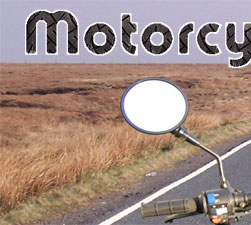|
It is hard to emphasize just how important brakes are to a motorcycle. Brakes are not flashy and exciting and often are neglected in favor of power boosting modifications. People forget that as a motorcycle engine's horsepower increases, its engine breaking capabilities tends to decrease. This forces the motorcycle's brakes to bear more of the burden of stopping. Also, if a motorcycle is loaded up for a weekend getaway or cross-country trip, the brakes have to work harder against the momentum of the extra weight. Even if a motorcycle is totally stock, it is critical to maintain your brakes and keep them in performing at their very best.
It is also important to understand a motorcycle's brake system before ever getting on it. The most common setup is to have a lever on the right handgrip to engage the front brake and a pedal near the right foot peg to engage the rear brake. Standard motorcycle brakes are hydraulically actuated to clamp down on the brakes rotors. The front brakes supply about 70% of the motorcycle's stopping power (car brakes are similarly proportioned. One common misconception is that using too much front brake can flip the rider over the handlebars. Despite the greater braking capabilities of a motorcycle's front brakes it is very difficult to make a flip a bike based on braking alone. To stop a motorcycle in the shortest distance possible, it is important to use both front and rear brakes in unison. Danger can arise when misuse of the brakes locks a wheel and causes the tire to skid. When skidding, control over the motorcycle is compromised.
To avoid a tire skid, motorcycle brakes should be applied firmly but smoothly. Progressively applying the front brake allows the weight of the motorcycle to shift forward, giving that tire extra traction. It is important to avoid abrupt application of the rear brake because as the weight shifts forward, decreasing weight on the rear tire makes it easier to lock up. In the event of a skid, a rider only has a split second to react so knowing the proper procedure is key.
A motorcycle's front tire is mainly responsible for steering the motorcycle. If the motorcycle's front tire locks up during braking, there will not be traction to facilitate steering. If your motorcycle's front wheel locks up, you should immediately release the brake and then reapply less abruptly.
A motorcycle's rear tire is mainly responsible for powering the motorcycle. Despite the fact that bikes only have two wheels, they are pretty stable as long as it is under power. As long as the rear wheel is driving the motorcycle, its rotational force will keep it upright and the wheels in line with each other. If the rear wheel locks up during braking, it will naturally drift out of line with the front wheel. If you release the brake and allow the rear wheel to spin under the power of the engine again, it will try to snap it back in line with the front wheel. This can cause a motorcycle to high side and can throw the rider off. High side crashes can be one of the most dangerous situations a motorcycle rider can encounter. If your motorcycle's rear wheel locks up, keep pressure of the brake. It is better to allow the rear wheel to skid than to risk a high side crash.
Many motorcycle riders are not familiar with all the brake options available. Most of these motorcycle brake variations are designed to make stopping as smooth as possible and avoid skidding.
- Integrated Brakes - When the motorcycle rider
applies the rear motorcycle brake, some front brake is
automatically engaged.
- Linked Brakes - If a motorcycle rider engages
either front or rear brake, some pressure will be applied
to the motorcycle's other brake automatically.
- Anti-Lock Brakes - Though more commonly found
in cars, anti-lock brakes function the same on motorcycles.
Anti-lock brakes are designed to reduce skidding or prevent
it altogether by rapidly pulsing the brakes during a maximum
braking situation.
A popular and relatively inexpensive motorcycle brake modification is to replace the stock rubber brake lines with braided steel lines. When the brakes are engaged, the hydraulic fluid is compressed and the pressure can stretch rubber lines a bit, especially when hot. This can make the motorcycle's brakes feel spongy. Steel brake lines limit how much the brake lines can expand, making the brakes more responsive. The shine of steel brake lines also looks great on just about any motorcycle. Though replacing the stock brake lines is a relatively simple procedure, I'm always hesitant to work on brakes. I'm all for working on your own motorcycle. It's a great way to familiarize yourself with how everything works and you can save money at the same time. With brakes, however, the risk just doesn't seem worth the reward. I would rather spend a little bit and have confidence in my brakes knowing that an experienced professional handled the installation than constantly be wondering if something like an air bubble in the lines would cause my motorcycle's brakes to fail when I need them most.
|






